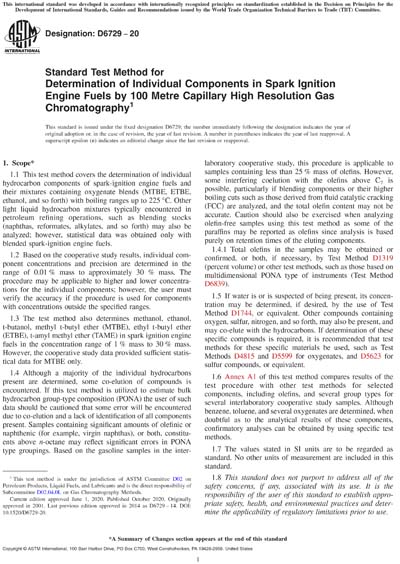Most recent
ASTM D6729-20
Standard Test Method for Determination of Individual Components in Spark Ignition Engine Fuels by 100 Metre Capillary High Resolution Gas Chromatography
1.1 This test method covers the determination of individual hydrocarbon components of spark-ignition engine fuels and their mixtures containing oxygenate blends (MTBE, ETBE, ethanol, and so forth) with boiling ranges up to 225 °C. Other light liquid hydrocarbon mixtures typically encountered in petroleum refining operations, such as blending stocks (naphthas, reformates, alkylates, and so forth) may also be analyzed; however, statistical data was obtained only with blended spark-ignition engine fuels.
1.2 Based on the cooperative study results, individual component concentrations and precision are determined in the range of 0.01 % mass to approximately 30 % mass. The procedure may be applicable to higher and lower concentrations for the individual components; however, the user must verify the accuracy if the procedure is used for components with concentrations outside the specified ranges.
1.3 The test method also determines methanol, ethanol, t-butanol, methyl t-butyl ether (MTBE), ethyl t-butyl ether (ETBE), t-amyl methyl ether (TAME) in spark ignition engine fuels in the concentration range of 1 % mass to 30 % mass. However, the cooperative study data provided sufficient statistical data for MTBE only.
1.4 Although a majority of the individual hydrocarbons present are determined, some co-elution of compounds is encountered. If this test method is utilized to estimate bulk hydrocarbon group-type composition (PONA) the user of such data should be cautioned that some error will be encountered due to co-elution and a lack of identification of all components present. Samples containing significant amounts of olefinic or naphthenic (for example, virgin naphthas), or both, constituents above n-octane may reflect significant errors in PONA type groupings. Based on the gasoline samples in the interlaboratory cooperative study, this procedure is applicable to samples containing less than 25 % mass of olefins. However, some interfering coelution with the olefins above C7 is possible, particularly if blending components or their higher boiling cuts such as those derived from fluid catalytic cracking (FCC) are analyzed, and the total olefin content may not be accurate. Caution should also be exercised when analyzing olefin-free samples using this test method as some of the paraffins may be reported as olefins since analysis is based purely on retention times of the eluting components.
1.4.1 Total olefins in the samples may be obtained or confirmed, or both, if necessary, by Test Method D1319 (percent volume) or other test methods, such as those based on multidimensional PONA type of instruments (Test Method D6839).
1.5 If water is or is suspected of being present, its concentration may be determined, if desired, by the use of Test Method D1744, or equivalent. Other compounds containing oxygen, sulfur, nitrogen, and so forth, may also be present, and may co-elute with the hydrocarbons. If determination of these specific compounds is required, it is recommended that test methods for these specific materials be used, such as Test Methods D4815 and D5599 for oxygenates, and D5623 for sulfur compounds, or equivalent.
1.6 Annex A1 of this test method compares results of the test procedure with other test methods for selected components, including olefins, and several group types for several interlaboratory cooperative study samples. Although benzene, toluene, and several oxygenates are determined, when doubtful as to the analytical results of these components, confirmatory analyses can be obtained by using specific test methods.
1.7 The values stated in SI units are to be regarded as standard. No other units of measurement are included in this standard.
1.8 This standard does not purport to address all of the safety concerns, if any, associated with its use. It is the responsibility of the user of this standard to establish appropriate safety, health, and environmental practices and determine the applicability of regulatory limitations prior to use.
1.9 This international standard was developed in accordance with internationally recognized principles on standardization established in the Decision on Principles for the Development of International Standards, Guides and Recommendations issued by the World Trade Organization Technical Barriers to Trade (TBT) Committee.
ASTM International [astm]

